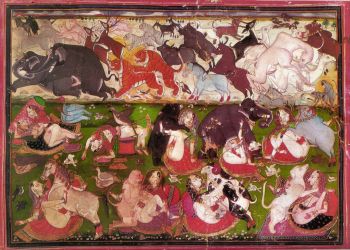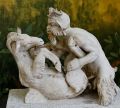Art
| Art, Culture, and Customs Zoo Culture |

|
| We have culture! |
Art is the expression of the soul, depicted in multiple forms throughout recorded history. Art involving Zoophillia has existed since Mankind first started making cave drawings. This article describes Zoophiliac art from the ages.
Examples
There is a lovely, very elegantly carved jade figure in china which depicts a woman and a dog having sex face to face. His paws are on her breasts and they stare lovingly into one another’s eyes.
Another piece of artwork from Asia, this one a Japanese piece, shows a woman (apparently a scribe, if the props are any indication) being mounted doggystyle and penetrated by a large white dog with black spots, ears that tip forward at the ends, and a long graceful tail like a German Shepherd’s. The animal’s claws, ribs, tongue and whiskers are accentuated, drawing the viewer’s eye to exactly what it is that makes the creature look so wolfish despite its clearly-domesticated color pattern, a form of piebald.
In what may be the most famous zoophilic imagery from the east, we have “The Dream of the Fisherman’s Wife”, which shows an octopus performing cunnilingus on a woman while using its tentacles in what appears to be a rather strong and utilitarian hold. A second octopus twines its tentacles around her, reaching one down to stimulate the nipple of her left breast. It was originally designed as a woodcut by Hokusai (a Japanese artist) but is now widely available as a print.
-
The Dream of the Fisherman’s Wife
An image from India depicts Nayika (a woman) intimately intwined with no less than eight different species, running the gamut from elephant and monkey to horse, ram, and bull, not to mention a bird, something that is either a baboon or bear, as well as an animal which looks fairly doglike but lacks a knot on its penis. Perhaps the artist was simply not intimately acquainted with canines? The top of the image depicts a great number of animals, each mating with one of their own species. The camels are even in the correct posture (kneeling down on the ground for the act) something uncommon in nature.

Other images from India depict a woman and dog having sex in the missionary position, an animal of undetermined species (with a nose like a Bull Terrier) mounting a woman from behind, another lady allowing a monkey to lick her intimate areas, and a man having sex with a pig while it performs oral sex on a second person – quite the exotic threesome!
The Lakshmana temple (built in the 10th century) is decorated with many sexual carvings, one of which depicts a man penetrating a horse in front of a crowd of jovial onlookers. One of the voyeurs is masturbating and seems to be offering his penis to the horse, perhaps attempting to ask for a blowjob from the equine. It is still on display in Khajuraho, India.
-
Zoophilia scene in Lakshmana Temple
The ancient Greeks, well-known for the penchant for human-animal intimacy, created a large amount of pottery depicting scenes of humans and animals getting to know one another carnally. Some depict horses; others, deer; there are goats as well as fragments of pottery on which the animal cannot be determined, but they are obviously quadrupeds! Their most popular contribution has been Pasiphae, who let a bull mate her!
The Romans had Leda and the swan, and aside from simply being reproduced again in many forms throughout history, it was also the inspiration of egg-and-dart moulding in architecture (sometimes referred to as egg-and-tongue by those who find the notion of a penis in their imagery to be distasteful).
When the ruins of Pompeii were originally preserved in ash, a nearby city (Herculaneum) also fell victim to the volcanic eruption. Not only did walls decorated with bestial art exist, there was also a statue that got dug up in the presence of a king! Known as “Pan and the Goat from the Villa of Papyri”, the human figure was actually a god who was himself the product of bestiality.
-
Pan and the Goat from the Villa of Papyri
Throughout the Middle Ages, bestiality became incredibly taboo due to prohibitions against it by the Church and religion’s position of power in the daily life of society. Simple excommunication (a refusal of others to talk to or trade with you) could prove disastrous for the entire family. Nevertheless, artists of the time would occasionally draw upon ancient myths and depict the scenes anew, oftentimes with great attention paid to every detail.
In 1928 a silent cartoon called “Eveready Harton in Buried Treasure[1]” was created. It was the tale of a very aroused man who witnesses a great many animals mating and then sees a woman masturbating. He goes over to see if she would like any assistance and it doesn’t take long for a crab to latch onto his penis, which then proceeds to hop off of his body and bounce away. The film is only a few minutes long but when he finally captures his penis and puts it back where it belongs, he sees a man having sex with a donkey! This arouses him so much that he attempts to have a go himself, but the donkey runs away at the last minute and Eveready Harton falls onto a cactus, hurting himself. When he finally gets all the needles out of his sensitive organ, he comes across a cow on the other side of a fence with a big hole in it. He decides it would make a perfect glory-hole and the cow is happy to oblige, wrapping her long tongue around his penis for the finale.
Pablo Picasso, one of the most famous artists of all time, has even done a bit of bestiality work of his own, although it is more suggestive than explicit. In one image, a centaur embraces and passionately kisses a woman who seems completely overwhelmed with her desire for him while a man and a woman observe. In a second, a minotaur and centaur (both part-human and part-animal) are intimately entwined. In still another image, a minotaur is seen laying with a woman beside a naked couple – they appear to be drinking alcohol and having an encounter which may be either group sex or simple exhibitionism. These are just a few of many examples of semi-bestiality depicted by the artist.
These days not only can one play as an animal (anthropomorphic or feral) and have sex with people on SecondLife, there are special models of animals for 3D-art-creation programs for which you may download anatomically correct genitalia in accordance with their species.
Controversies
Many artists create work of a zoophilic nature, from amateurs doing it on a pen and paper to professionals with their air-light laptops and complex animation programs. Everybody is adding their hard work for a community of like minded individuals gathering around their shared love of one thing: animals.
But there has been opposition from anti-zoos. They have done everything from preventing the installation of Domestikator by the Louvre to making the Esplanad in Singapore remove an image of a human being and a rooster. What did a giant structure and a little sketchy image have in common aside from looking like they showed people having sex with animals? Both of them had been displayed in public, despite being seen as inappropriately sexual and offensive to sensitive viewers.
Derrik Santini’s photographic portrayal of Leda and the Swan was removed due to concerns from Metropolitan Police in the UK. One must wonder how much art is not displayed due to such prejudice in public perception?
- ↑ Wikipedia contributors. (2023, November 9). Eveready Harton in Buried Treasure. In Wikipedia, The Free Encyclopedia. Retrieved 19:07, November 28, 2023, from https://en.wikipedia.org/w/index.php?title=Eveready_Harton_in_Buried_Treasure&oldid=1184276534


